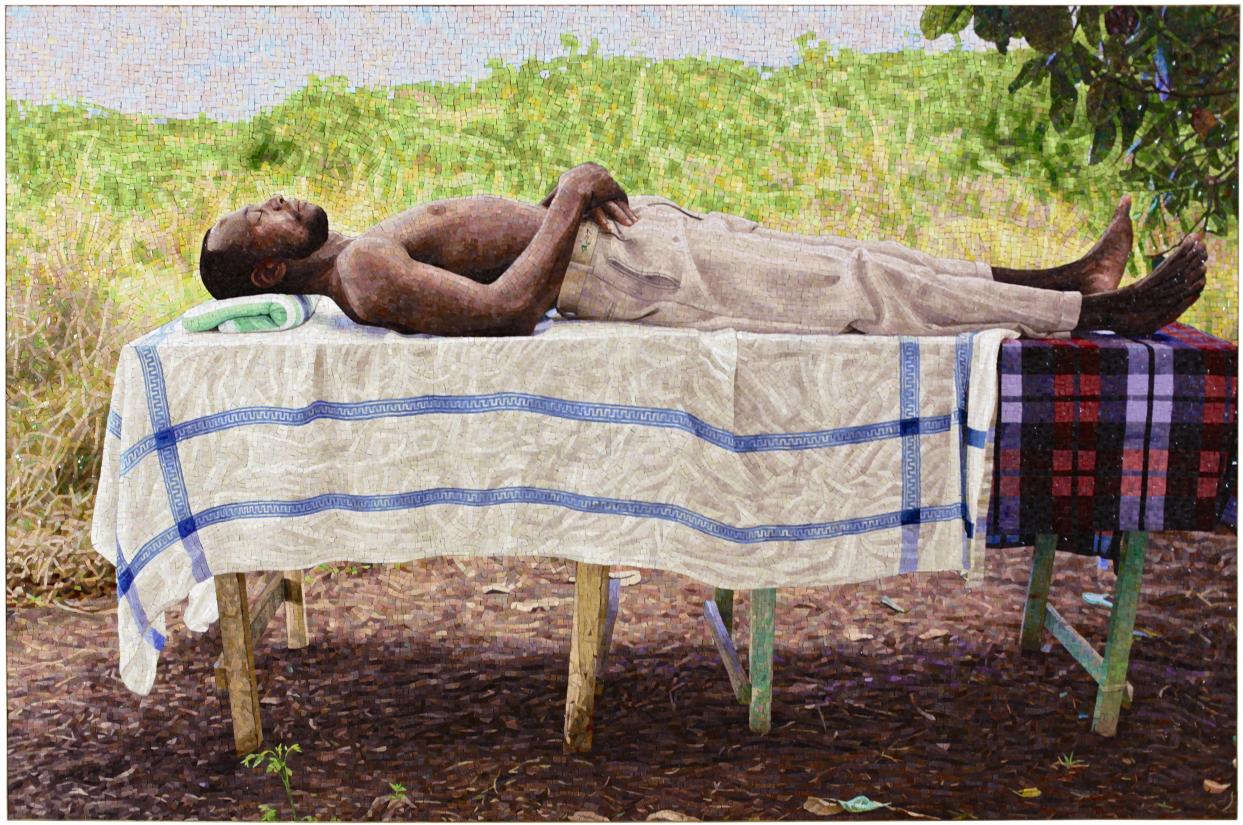The mosaic shows a man who appears to be sleeping, stretched out across a couple of tables covered with tablecloths. He is lying in the shade of a large tree, and in the background is a verdant landscape. Because it is a mosaic, the piece appears almost as a pixelated photograph.
Untitled (Haiti) illustrates the wide and diverse potential of mosaics as a medium. Frandsen began to work with mosaics around 2007. In contrast to his earliest pieces, where the mosaic tiles formed a completely level surface, his recent works feature distinct variations in level, which causes the tiles to capture and reflect the light in a unique way. The tiles also show a wider range of materials, and thus the piece not only represents an expansion of the range of topics addressed in Frandsen’s work but also of his technique.
Gorm, the body-healer
A journey to Haiti had a decisive impact on Erik A. Frandsen’s artistic development, with regard to both his choice of topics and his artistic expression. Haiti is one of the poorest countries in the Western world. On his visit to Haiti, Frandsen met Gorm, a body-healer, who told him of the pains suffered by Haitian farm labourers.
Gorm had been asked to come out and massage the workers. Under a large holy tree in the middle of a fallow field, he set up a couple of tables, and the workers showed up in large numbers. He treated them all, and the effect was obvious, as their posture was significantly improved after the treatment. The man portrayed in the mosaic fell asleep after his massage.
Untitled (Haiti) was recently presented at the Grønningen exhibition at Gl. Strand in Copenhagen.
‘The young wild ones’
Frandsen’s practice dates back to the 1980s. At the time, he was a part of ‘the young wild ones’, an art movement generally associated with revitalizing painting after a period in art history when the Danish and international art scene was strongly influenced by minimalism and conceptual art.
In his works, Frandsen often transfers elements from one medium to another in a synthesis of variegated materials and working methods that gives rise to entirely new expressions. Frandsen’s works encapsulate transience and fleeting moments in otherwise solid materials and thus eternalizes them.
Horsens Art Museum
Horsens Art Museum aims to collect many works by relatively few artists, Erik A. Frandsen among them. The museum has what is probably the biggest museum collection of the artist’s work, including paintings, photographs, mosaics, neon installations, sculpture, scagliola and graphic art. The collection goes back to Frandsen’s early work from 1983.
Untitled (Haiti) is presented in this year’s summer exhibition, which focuses on Erik A. Frandsen’s work.
About Erik A. Frandsen
Erik A. Frandsen (b. 1957) lives and works in Copenhagen. As an artist he self-taught, but in 1976–1979 he studied ceramics in Greece, sculpting in Italy and graphic art in France. Erik A. Frandsen is represented in all major Danish art museums and has held solo exhibitions both in Denmark and abroad. In 1996 he was awarded the Eckersberg Medal, and in 2014 he received the Danish Arts Foundation’s life-long honorary grant. Further, in 2009 he was awarded the New Carlsberg Foundation’s Artist Grant.



